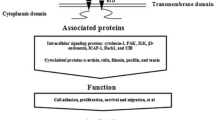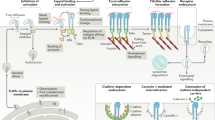Abstract.
Integrins are a family of adhesive receptors consisting of α- and β-subunits which attach cells together via adhesive protein ligands or bind cells to extracellular matrix. They are found on virtually all cell types and link the external ligand to the cytoskeleton of the cell. Integrins also act as signal transducers both from the outside of the cell to the interior and also inside-out. Their main functions are in recognition and in tight but regulated binding. The series of reviews presented here cover both basic aspects of integrin function, including signal transduction, snake disintegrins and structure and function of I-domains in some integrin α-subunits, as well as the role of integrins in diseases, cancer, inflammation and cardiovascular diseases. The search for suitable inhibitors of integrins for treatment of these diseases and future prospects for their use are also discussed.
Similar content being viewed by others
Author information
Authors and Affiliations
Additional information
Rights and permissions
About this article
Cite this article
Clemetson, K. Introduction: integrins, dynamic cell receptors. CMLS, Cell. Mol. Life Sci. 54, 499–501 (1998). https://doi.org/10.1007/s000180050178
Issue Date:
DOI: https://doi.org/10.1007/s000180050178




